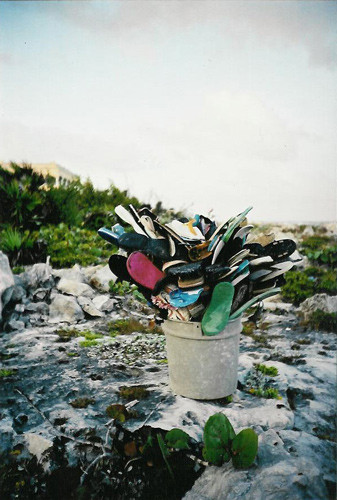Gareth Moore
06 - 24 May 2008

© Gareth Moore
How many people have cut their feet on broken glass in the Yucatan Peninsula since 1969, 2003
Courtesy Catriona Jeffries
How many people have cut their feet on broken glass in the Yucatan Peninsula since 1969, 2003
Courtesy Catriona Jeffries
GARETH MOORE
Passengers: 1.9
May 6–24, 2008
The Vancouver-based artist Gareth Moore is concerned with restoring use value to the discarded, as in Transformers (2003), a project that involved walking through Vancouver and looking for abandoned articles of clothing on the streets and in dumpsters. For each item that he found, Moore swapped the same article that he was wearing until his clothing had entirely changed. Always working in direct response to a specific place, Moore reconfigures existing elements and found objects in gently subversive ways to focus attention on the overlooked or the mundane. His pieces often seem to materialize from exercises in economics while subtly examining the habits of consumerism and the concept of recycling. In one of his best-known works, St. George Marsh (2005–6), he ran a small corner shop in Vancouver together with his collaborator Jake Gleeson. In an investigation of worth and worthlessness, the shop sold an eclectic mix of items, from exotic sodas and candy to sticks, rocks, and broken media equipment while also providing free books and arranging displays of things that were not for sale at all.
Passengers: 1.9
May 6–24, 2008
The Vancouver-based artist Gareth Moore is concerned with restoring use value to the discarded, as in Transformers (2003), a project that involved walking through Vancouver and looking for abandoned articles of clothing on the streets and in dumpsters. For each item that he found, Moore swapped the same article that he was wearing until his clothing had entirely changed. Always working in direct response to a specific place, Moore reconfigures existing elements and found objects in gently subversive ways to focus attention on the overlooked or the mundane. His pieces often seem to materialize from exercises in economics while subtly examining the habits of consumerism and the concept of recycling. In one of his best-known works, St. George Marsh (2005–6), he ran a small corner shop in Vancouver together with his collaborator Jake Gleeson. In an investigation of worth and worthlessness, the shop sold an eclectic mix of items, from exotic sodas and candy to sticks, rocks, and broken media equipment while also providing free books and arranging displays of things that were not for sale at all.
